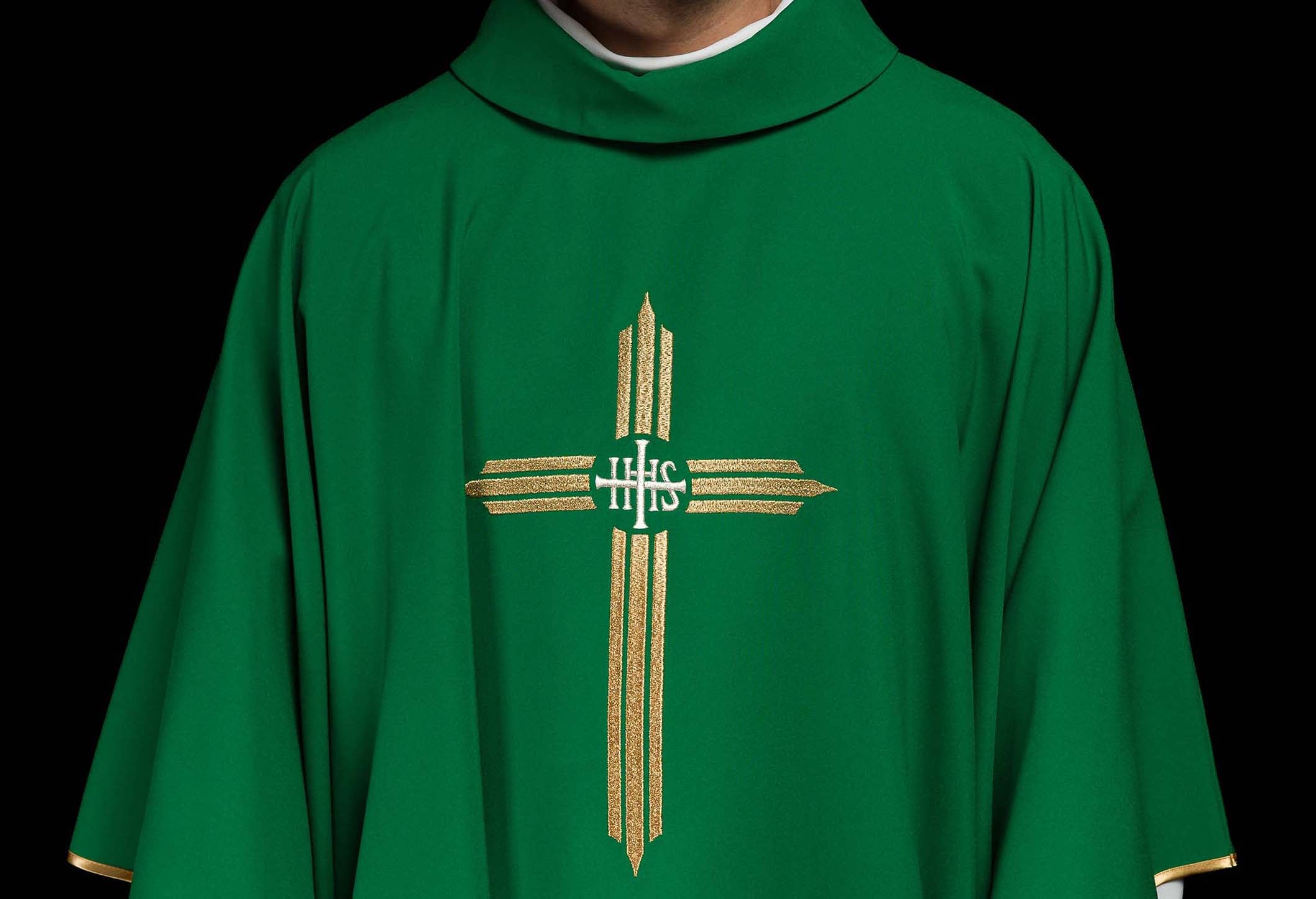
What Vestments to Wear for the Solemnity of Christ the King? A Guide to Liturgical Elegance and Symbolism
What Ornate for the Solemnity of Christ the King? A Guide to Liturgical Elegance and Symbolism
The Solemnity of Christ the King of the Universe, which closes the Catholic Church's liturgical year, is a day of exceptional significance. It is a time when we jointly profess faith in Christ as King, not only spiritual but also the one who reigns over all creation. The liturgical setting of this day should reflect the majesty, dominion, and solemnity of this feast. A crucial element of this setting is, of course, the liturgical vestments, and in particular, the chasuble. Choosing the appropriate chasuble for the Solemnity of Christ the King is therefore not only a matter of aesthetics but, above all, a deeply theological message.
Why is Color Important in Liturgy?
The colors of liturgical vestments are not accidental. Each carries a specific symbolic meaning and is associated with a particular period or feast in the liturgical year. Knowing these meanings allows for a deeper experience of the celebration and a better understanding of its message.
What Colors are Traditionally Used for the Solemnity of Christ the King?
Although the liturgy does not strictly impose one color for the Solemnity of Christ the King, two colors dominate in tradition and church practice, symbolizing kingship and supreme authority:
- Gold: Gold is commonly associated with royalty, majesty, glory, and victory. The use of a gold chasuble on the Solemnity of Christ the King emphasizes His divine dominion and triumph over sin and death. It is a universal color that can be used in any liturgical period but is particularly suited to feasts of a solemn and royal nature.
- White/White-Gold: White symbolizes purity, innocence, light, victory, and joy. It is the color of the Easter and Christmas seasons but also the liturgy in honor of Jesus Christ, Angels, and Saints. A white chasuble, often enriched with gold embroidery or applications, perfectly reflects the glorious nature of Christ the King, His immortality, and eternal reign. The combination of white and gold is particularly recommended for this solemnity, combining purity with royal majesty.
When Can Other Colors Be Used?
In some cases, the use of other colors is also permissible, although they are less frequently chosen for the Solemnity of Christ the King:
- Green: Symbolizes hope and life, which can refer to Christ's dominion over life and the hope of salvation. However, because this Solemnity closes the liturgical year and its character is more eschatological (concerning the end times and Christ's reign), the green color is less often preferred.
Symbolism of Embroidery and Motifs on the Chasuble
In addition to color, a key element of the chasuble is its decoration – embroidery and applications. The symbolism of these elements should harmonize with the message of the Solemnity of Christ the King.
Most Often Chosen Symbols for Royal Chasubles
When choosing a chasuble for this solemnity, it is worth paying attention to the following motifs:
- Monogram IHS or Chi Rho: These classic Christological symbols, meaning "Jesus Christ Savior of mankind" or the Greek abbreviation of Christ's name, are a universal expression of reverence for Jesus.
- Cross: A symbol of the Passion, sacrifice, but above all, Christ's triumph over death. It can be represented in various forms, often decorated to emphasize its royal character.
- Paschal Lamb: A symbol of Jesus Christ as the Sacrifice for the sins of the world, who conquered death. It is a powerful Christian symbol, emphasizing the saving mission of Christ the King.
- Plant motifs (e.g., vine, ears of wheat): Can symbolize Christ as the source of life, the Eucharist, and the abundance of graces.
- Crown: A direct reference to the royal reign of Christ. The crown can be stylized, decorated with stones, which adds to the chasuble's majesty.
- Sun or light: Symbolizes Christ as the Light of the world, the source of truth and life.
- Seals or symbols of the monarch: Sometimes, more subtle references to royal symbols are used, which are not directly religious but refer to the idea of dominion and authority.
Hand vs. Computer Embroidery – Which to Choose?
When choosing a chasuble, the technique of embroidery is also crucial. Both hand and computer embroidery have their advantages:
- Hand embroidery: Is more traditional and often offers greater depth of detail and uniqueness of each piece. Hand-embroidered items can be more refined, using precious threads and embellishments.
- Computer embroidery: Is usually more precise and repeatable, allowing for the creation of intricate designs with perfect accuracy. It is also often a more economical option.
Many companies, including HAFTINA TEXTILE GROUP, offer products combining both techniques to ensure the highest quality and beauty of the embroidery.
Roman vs. Gothic Chasuble – Which Works Better?
The choice between a Roman and a Gothic chasuble is a matter of style and preference, but also symbolism.
- Roman Chasuble: Characterized by wide, flat sleeves and often decorated with a "cord" – a vertical strip running through the center of the chasuble (front and back), often richly embroidered. It is more traditional and classic.
- Gothic Chasuble (also known as cope or purple with a narrow strip): Has narrower sleeves and is more fitted to the figure. It often has richly decorated panels on the front and back, which can be more exposed. Its more modern form can be seen as more dynamic.
For the Solemnity of Christ the King, both types of chasubles can be appropriate if their colors and decorations emphasize the majesty of the feast. A gold or white-gold Roman chasuble with rich IHS embroidery or a crown symbol will always be an elegant choice. Similarly, a gold Gothic chasuble with a motif of the triumphal cross or Paschal Lamb will also perfectly emphasize the character of the solemnity.
What to Consider When Choosing a Material?
The material from which the chasuble is made affects not only its appearance but also its wearing comfort. Popular and valued materials include:
- Velvet: Luxurious and elegant, perfectly suited for solemn occasions. It accepts embroidery well and gives depth to the vestments.
- Jacquard fabrics: Often have their own subtle patterns that add elegance to the vestments without the need for intense embroidery.
- Lightweight fabrics (e.g., Sacrolite): Offer wearing comfort, especially in warmer months or during long celebrations. They are durable and easy to care for.
- Silk or its imitations: Give the vestments shine and lightness, emphasizing the solemn character of the liturgy.
It is important that the material is of good quality, durable, and properly arranged, emphasizing the beauty of the embroidery and the shape of the chasuble.
Practical Tips for Choosing and Caring for a Chasuble
When purchasing a chasuble for the Solemnity of Christ the King, it is worth paying attention to several practical aspects:
- Quality of workmanship: Carefully check the seams, the way it is finished, and above all, the quality and durability of the embroidery.
- Size and fit: Make sure that the chasuble is appropriate in terms of length and width for the user. It is worth consulting the supplier to choose the right size.
- Ease of care: Ask about recommendations for washing and ironing. Liturgical vestments often require special care.
- Symbolism consistent with the intention: Choose a chasuble whose symbols best reflect the theological message of the Solemnity of Christ the King and meet spiritual needs.
Where to Buy a High-Quality Chasuble for the Solemnity of Christ the King?
When looking for the perfect chasuble, it is worth relying on trusted sources. Companies such as HAFTINA TEXTILE GROUP specialize in the production of high-quality liturgical vestments, offering a wide selection of materials, designs, and embroidery techniques. Available on haftinausa.com, the collections are characterized by attention to detail, compliance with liturgical tradition, and modern design. You will find both classic chasubles and more sophisticated ones, decorated with stones or made of luxurious fabrics.
Summary – The Chasuble as a Testimony of Faith
The Solemnity of Christ the King of the Universe is an excellent opportunity to emphasize the royal majesty of Jesus through a properly selected liturgical vestment. A gold or white-gold chasuble, decorated with symbols of His reign, love, and saving sacrifice, will not only be beautiful but, above all, full of deep theological meaning. When choosing a chasuble, let us remember that it is not only an element of the clergyman's attire but a testimony of faith and an expression of reverence for the King of kings.
If you are looking for a unique chasuble, richly decorated with gold embroidery for the Solemnity of Christ the King, which will emphasize the majesty of this feast, we cordially invite you to familiarize yourself with the rich offer of HAFTINA TEXTILE GROUP on haftinausa.com. Our chasubles, made of the best materials and with attention to every detail, are an excellent combination of tradition, quality, and symbolism, which will certainly enrich the celebration of this special solemnity.
```




